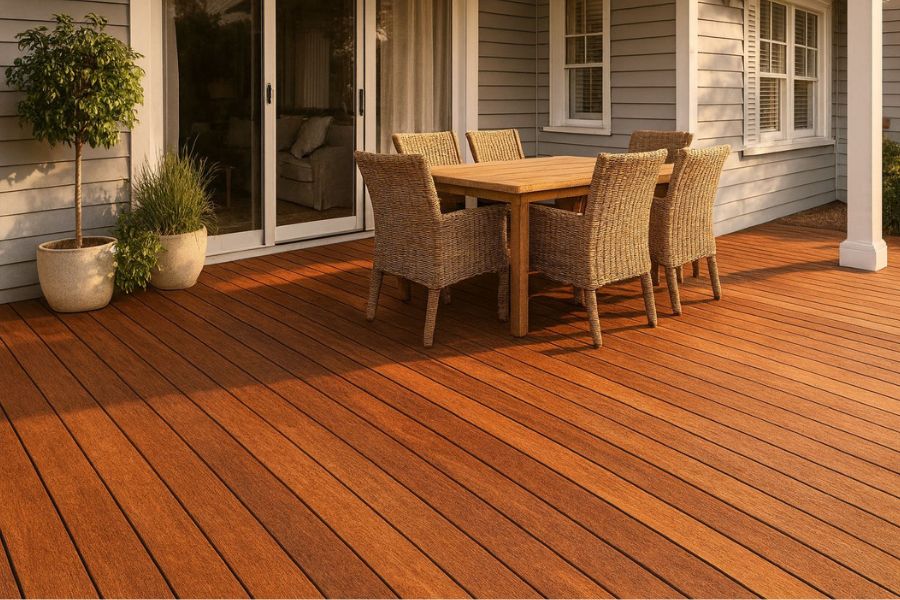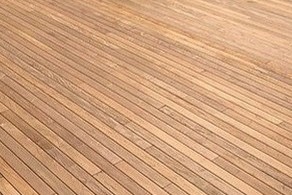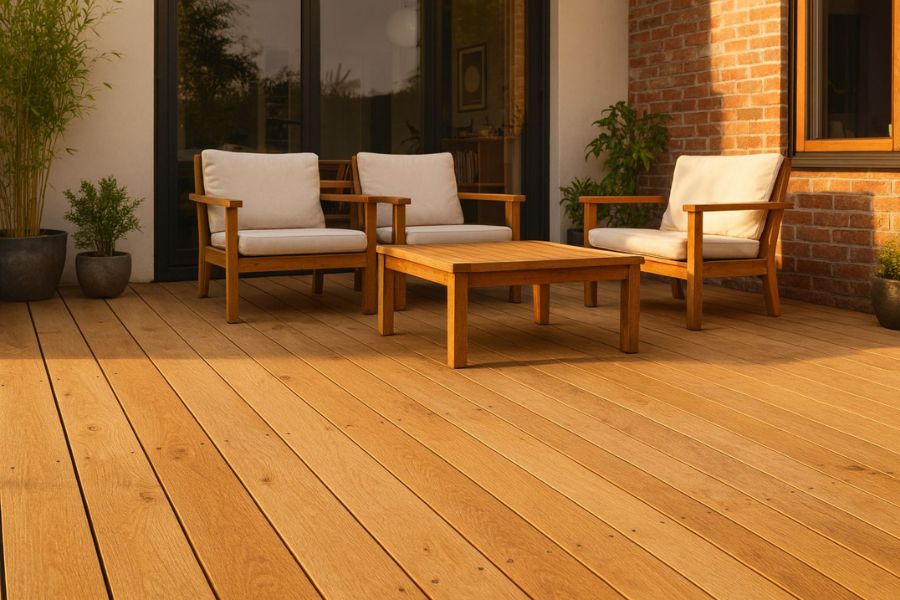Oak Decking - 140 x 22mm - Smooth
Product Code: D-000939£48.28 per m² ex. vat
Lengths available:
- 2000mm
- 2500mm
- 3000mm
- 3500mm
- 4000mm
Enter your deck area for estimate price:
Area
Price (Based on 2500mm)
Contact our experts for a price including delivery and recommended fixings:

We believe in the power of premium materials to transform spaces, inside and out.
We strive to deliver your products as promptly as possible, so you can start enjoying them right away.
Our customers are at the heart of everything we do. That’s why we are proud to showcase our Trustpilot reviews.
Shopping with us is straightforward and stress-free. Our dedicated team is just a call or email away if you need assistance.
- European Oak decking boards
- Dimensions: 140 x 22mm
- Smooth faces with eased edges
- Machined to order
- Mixture of Rustic to Prime grade, with cat paw, small, medium, and large knots
- Exterior Oak develops natural surface splits, shakes, and cracks over time
- Some boards may contain sap and surface splits, but are structurally sound
- Colour varies from light brown to medium honey
- Various widths available
- Recommend using a decking wrench for installation
- Decking wrench is a self-locking tool for straightening bent boards during installation
- Decking wrench hire service available
Our smooth European Oak boards and exhibit a range of natural hues from light brown to medium honey. They create a light, effortlessly stylish decking solution that complements any environment. Over time, the oak will develop characterful surface imperfections, adding to its charm. Featuring a mix of Rustic to Prime grade, the boards may showcase knots, sap, and surface splits.
One of our greatest strengths is our well-organized delivery system. Whether we use external couriers or our own fleet of vehicles, we ensure your decking arrives promptly and in excellent condition. Delivery charges are calculated based on your postcode, the distance to your location, and the length and weight of the materials. For more details, please see our Delivery Terms & Conditions.
Overview: Understanding European Oak
European oak is a dense, durable, slow-grown hardwood that creates a light, natural-appearing deck blending sympathetically with most surroundings. Our oak boards vary in colour from very light brown through to medium honey tones, offering authentic natural beauty. The timber is a mixture of Rustic to Prime grade, allowing for characterful features including cat paw, small, medium and large knots. Some boards may contain sap and surface splits, which are structurally sound and within grade specifications.
Preparation and Understanding Oak’s Natural Characteristics
Before installation, it’s essential to understand that oak is a living material that responds to environmental conditions. All exterior oak will develop surface splits, shakes and cracks over time—this is a natural occurrence with this species and these features can even close back up again with the changing seasons. This natural movement is characteristic of oak and does not affect structural integrity. Our oak boards come planed smooth with eased long edges on both sides, unfinished and ready for oil treatment if desired.
Board Specifications and Preparation
Board Availability Whilst stock levels vary, our oak boards are generally available in lengths of 3m and 3.5m. Please contact us with any specific requirements you may have for your project.
End Grain Protection Any boards that are cut on site must have beeswax or end grain sealer applied to the freshly trimmed ends immediately. This critical step prevents excessive moisture absorption and minimises end checking, protecting the integrity of your oak decking.
Fixing Methods
Face Screwing (Recommended for Oak) The traditional method offering maximum strength and reliability, particularly suited to oak’s natural movement characteristics. Simply screw through the face of the board into your sub-frame, with the option to plug holes for improved aesthetics. This proven technique provides the secure fixing that oak decking requires.
Hidden Fastening Systems Please note: We do not recommend hidden fastening systems for oak decking installations. Oak’s natural movement characteristics make face screwing the preferred and more reliable installation method for long-term performance.
Installing Face Screwed Oak Decking
Oak requires careful attention to proper fixing techniques:
- Always pilot drill before fitting screws to prevent splitting in the dense hardwood
- Drill holes 2mm oversize to allow for natural expansion and contraction
- Use stainless steel decking screws exclusively to ensure a firm hold and prevent corrosion
- Maintain 6mm gaps between oak decking boards to accommodate seasonal movement
- Install on joists with 400mm centre-to-centre spacing for optimal support
- Each screw hole can be plugged with matching oak plugs for improved aesthetics
- Countersink screws appropriately when plugging for a flush finish
Board Spacing and Movement
Oak’s density and natural characteristics require specific spacing:
- Maintain 6mm gaps between oak decking boards (larger than tropical hardwoods)
- This spacing accommodates oak’s natural expansion and contraction with seasonal changes
- Proper gapping allows the timber to move naturally without warping or buckling
- Remember that surface splits and shakes are normal and may open and close seasonally
Sub-Frame Construction
A robust sub-frame is essential for oak decking installations:
- Use pressure-treated softwood joists for your sub-frame
- Maintain 400mm centre-to-centre joist spacing throughout installation
- Ensure adequate ventilation beneath the deck to prevent moisture accumulation
- Plan joist layout to accommodate 3m and 3.5m board lengths efficiently
- Please note: We do not supply softwood sub-frame materials—source from your local timber merchant
Professional Installation Tools
We strongly recommend using a hardwood decking wrench during installation. This specialized self-locking deck board straightening tool holds bent boards straight whilst fasteners are installed, ensuring professional results and uniform appearance across your entire oak deck. This tool is particularly valuable when working with oak’s natural density and weight.
Grade and Character Features
Understanding your oak decking’s natural variation:
- Mixture of Rustic to Prime grade offering authentic character
- Cat paw, small, medium and large knots are within specification
- Colour variation from very light brown to medium honey tones
- Some boards may contain sap—this is structurally sound and within grade
- Surface splits are within grade and do not affect structural integrity
- Each board is unique, contributing to the natural beauty of your deck
Finishing at Installation
Oak decking comes unfinished at installation:
- Boards arrive planed smooth with eased long edges
- Ready for oil treatment if desired (can be applied before or after installation)
- All cut ends must be sealed with beeswax or end grain sealer immediately after cutting
- Consider your finishing preference before installation begins
Essential Installation Reminders
- Maintain 400mm centre-to-centre joist spacing throughout
- Use 6mm gaps between oak boards (not 4mm like tropical hardwoods)
- Always use stainless steel screws for secure, corrosion-resistant fixing
- Pre-drill all screw holes 2mm oversize to allow for expansion
- Seal all cut ends immediately with beeswax or end grain sealer
- Do not use hidden fastening systems with oak decking
- Ensure adequate cross-ventilation beneath the deck
- Accept and embrace oak’s natural characteristics including surface splits and colour variation
Why Choose Face Screwing for Oak?
Oak’s unique movement characteristics make face screwing the recommended installation method. The species’ density and tendency to move seasonally mean that hidden fastening systems cannot provide the secure hold required for long-term performance. Face screwing allows the necessary flexibility while maintaining board security, and any screw holes can be plugged with matching oak for a refined finish.
Need Help?
While professional installation is advised for best results, we’re here to support DIYers with oak-specific installation advice and technical guidance. Understanding oak’s natural characteristics and proper installation techniques is essential for a beautiful, long-lasting deck. Contact us for tailored support, specific board length availability, or any questions about your oak decking project.
Overview: European Oak Decking Care and Maintenance
European Oak is a dense, durable hardwood with colours ranging from light brown to medium honey. With proper care, your oak deck will provide 25-40+ years of reliable service while developing beautiful character over time.
Understanding European Oak
Natural Characteristics
- Dense, slow-grown hardwood
- Light brown to medium honey colour
- Rustic to Prime grade with natural knots
- May contain sap and surface splits (structurally sound)
- Supplied unfinished, ready for oil if desired
Natural Splitting (Normal and Expected)
- All exterior oak develops surface splits, shakes, and cracks over time
- Completely natural—does not affect structural integrity
- Splits can close back up with changing seasons
- Adds to authentic, natural character
- Do not attempt to fill splits
Natural Weathering
- Without treatment, oak weathers to silvery-grey over 12-24 months
- UV rays and moisture cause gradual colour change
- Weathering is superficial and doesn’t affect durability
- Many embrace the natural weathered aesthetic
Initial Treatment
- End Grain Sealing (Critical): Apply beeswax or sealer to all cut ends immediately
- UV Protection (Optional): Apply hardwood oil within first few weeks if preserving colour
Colour Options
Natural Silver-Grey (Low Maintenance)
- Allow natural weathering
- Simply sweep regularly
- Minimal effort required
Maintain Honey Colour (Higher Maintenance)
- Apply UV-resistant hardwood oil annually (spring/autumn)
- High-sun areas need more frequent reapplication
- Requires consistent commitment
Cleaning
Weekly
- Sweep with soft brush
- Remove leaves and debris
- Clear 6mm gaps between boards
Twice Yearly (Spring/Autumn)
- Deep clean with hardwood-specific cleaners
- Use two-part cleaner/brightener for weathered wood
- Dry 1-2 days before oiling
- Remove all debris from gaps
Pressure Washing
- Not recommended—can damage fibres
- If necessary: maximum 1,200 PSI (8 MPa), 30cm distance, fan spray
Oil Application
- Clean surface thoroughly
- Dry completely (1-2 days)
- Lightly sand if needed
- Remove dust
- Apply hardwood oil per instructions
Seasonal Care
- Spring: Deep clean, inspect, check fasteners, reapply oil if maintaining colour
- Summer: Regular sweeping, spot clean spills
- Autumn: Remove leaves, deep clean, final oil application
- Winter: Remove snow with plastic shovel (never metal), clear ice
Ventilation and Drainage
- Maintain 45cm clearance from ground
- Ensure airflow beneath structure
- Keep vegetation trimmed back
- Clear debris from 6mm gaps (oak requires wider gaps than tropical hardwoods)
- Prevent standing water
Annual Inspection
- Check all stainless steel fasteners (tighten as needed)
- Inspect for loose or damaged boards
- Verify proper drainage
- Clear 6mm gaps of debris
- Monitor surface splits (normal)
- Check structural integrity
Stain Management
- Tannin/Food/Beverages: Clean immediately with mild soap and water
- Grease/Oil: Warm soapy water
- Mould/Mildew: Use hardwood cleaner, improve ventilation
- Prevention: Clean spills promptly, use furniture pads
Restoration
When wood looks weathered or water no longer beads:
- Clean with hardwood cleaner
- Dry completely
- Lightly sand with 80-grit
- Remove dust
- Apply hardwood oil
Common Issues
- Cupping: Ensure proper ventilation, keep 6mm gaps clear
- Movement: Natural seasonal expansion/contraction—maintain 6mm gaps
- Surface Roughness: Light sanding, reapply oil
- Mould: Clean regularly, improve ventilation
Maintenance Frequency
- Weekly: Sweep and remove debris
- Twice Yearly: Deep clean
- Annually: Inspection, oil if maintaining colour
- Every 2-3 Years: Light sanding/refinishing if needed
Best Practices
- Accept natural splitting—it’s oak’s character
- Maintain 6mm gaps (wider than tropical hardwoods’ 4mm)
- Use only stainless steel fixings
- Seal cut ends immediately with beeswax or sealer
- Keep surface and gaps clean
- Ensure excellent ventilation
- Choose maintenance approach early (grey vs. honey)
- Regular sweeping prevents most problems
- Never use hidden fastening systems with oak
Key Differences from Tropical Hardwoods
- More surface splitting (natural and acceptable)
- Requires wider 6mm gaps vs. 4mm
- Lighter natural colour
- More seasonal movement
- Hidden fastenings not recommended
- More affordable with local sourcing
Need Help?
European Oak offers exceptional beauty and natural character. Accept surface splits as oak’s charm, maintain 6mm spacing, and follow regular cleaning for 25-40+ years of reliable service. For advice or product recommendations, contact our experienced team for tailored guidance.






